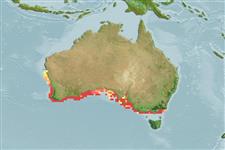Actinopterigi (pesci con pinne raggiate) >
Perciformes (Perch-likes) >
Arripidae (Australian salmon)
Etymology: Arripis: Latin, arripio, arripere = to take something suddenly.
Ambiente / Clima / Range
Ecologia
; marino; salmastro; distribuzione batimetrica 1 - ? m (Ref. 6390). Temperate, preferred 17°C (Ref. 107945); 26°S - 39°S, 112°E - 150°E
Eastern Indian Ocean: endemic to the southern coasts of Australia.
Size / Peso / Age
Maturity: Lm ? range ? - ? cm
Max length : 41.0 cm FL maschio/sesso non determinato; (Ref. 27296); Peso massimo pubblicato: 800.00 g (Ref. 27296); Età massima riportata: 7 anni (Ref. 27652)
Spine dorsali (totale): 9; Raggi dorsali molli (totale): 16; Spine anali 3; Raggi anali molli: 10; Vertebre: 25. Large eyes, diameter of which about one fifth of the head length. Body scales are slightly rough to touch. Body coloration: green above and silvery below with vertical rows of golden spots on the upper sides, tips of the caudal fin are black. Juveniles have dark golden bars on their sides (Ref. 6390). Length of upper lobe of caudal fin < 29.9% SL (Ref. 9701).
Usually found inshore in bays and estuaries over seagrass beds or near areas of seaweed (e.g. kelp), on rocky reefs, and along ocean beaches. Juveniles are found in inshore coastal waters, bays and inlets (Ref. 6390). Feed on small fish and prawns (Ref. 27946).
Both small, undeveloped ova (eggs) and larger ripe ova are present in the ovary at the same time. This phenomenon suggests that these species are either partial spawners (i.e. only some of the ova are spawned each time) or that the small ova remain in the ovary after spawning and are resorbed (Ref. 27945).
Kailola, P.J., M.J. Williams, P.C. Stewart, R.E. Reichelt, A. McNee and C. Grieve, 1993. Australian fisheries resources. Bureau of Resource Sciences, Canberra, Australia. 422 p. (Ref. 6390)
IUCN Red List Status (Ref. 115185)
CITES (Ref. 94142)
Not Evaluated
Threat to humans
Harmless
Human uses
Pesca: commerciale; Pesce da pesca sportiva: si
Informazioni ulteriori
BibliografiaAcquacolturaProfilo di acquacolturaVarietàGeneticaFrequenze allelicheEreditarietàMalattieElaborazioneMass conversion
CollaboratoriImmaginiStamps, CoinsSuoniCiguateraVelocitàModalità di nuotoArea branchialeOtolithsCervelliVista
Strumenti
Special reports
Download XML
Fonti Internet
